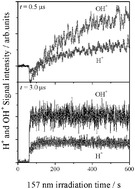A theoretical and experimental study on translational and internal energies of H2O and OH from the 157 nm irradiation of amorphous solid water at 90 K†
Abstract
The photodesorption of

Maintenance work is planned for Wednesday 1st May 2024 from 9:00am to 11:00am (BST).
During this time, the performance of our website may be affected - searches may run slowly and some pages may be temporarily unavailable. If this happens, please try refreshing your web browser or try waiting two to three minutes before trying again.
We apologise for any inconvenience this might cause and thank you for your patience.
* Corresponding authors
a
SINTEF Materials and Chemistry, P.O. Box 4760, 7465 Trondheim, Norway
E-mail:
stefan.andersson@sintef.no
b Department of Chemistry, Physical Chemistry, University of Gothenburg, 41296 Gothenburg, Sweden
c Leiden Observatory, Leiden University, P. O. Box 9513, 2300 RA Leiden, The Netherlands
d Leiden Institute of Chemistry, Leiden University, P. O. Box 9502, 2300 RA Leiden, The Netherlands
e
Department of Molecular Engineering, Kyoto University, Kyoto 615-8510, Japan
E-mail:
yabushita@moleng.kyoto-u.ac.jp
f School of Chemistry, University of Bristol, Bristol BS8 1TS, UK
The photodesorption of

 Please wait while we load your content...
Something went wrong. Try again?
Please wait while we load your content...
Something went wrong. Try again?
S. Andersson, C. Arasa, A. Yabushita, M. Yokoyama, T. Hama, M. Kawasaki, C. M. Western and M. N. R. Ashfold, Phys. Chem. Chem. Phys., 2011, 13, 15810 DOI: 10.1039/C1CP21138B
To request permission to reproduce material from this article, please go to the Copyright Clearance Center request page.
If you are an author contributing to an RSC publication, you do not need to request permission provided correct acknowledgement is given.
If you are the author of this article, you do not need to request permission to reproduce figures and diagrams provided correct acknowledgement is given. If you want to reproduce the whole article in a third-party publication (excluding your thesis/dissertation for which permission is not required) please go to the Copyright Clearance Center request page.
Read more about how to correctly acknowledge RSC content.
 Fetching data from CrossRef.
Fetching data from CrossRef.
This may take some time to load.
Loading related content
